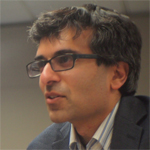SAN FRANCISCO—An athletic 19-year-old male has an episode of rhabdomyolysis, a breakdown of muscle tissue that leads to contents of muscle fiber in the blood, after weight-lifting and basketball drills. But his labs come back normal. He cuts down on his exercise, but has a second episode four months later, then finally sees a rheumatologist…








